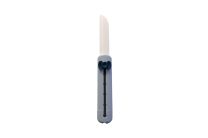Live Rock in Reef Tanks - All you need to know!
30.01.2017 00:00

Live rocks are an indispensable part for a healthy seawater aquarium. They had a breakthrough in the aquaristic scene in the 1990s and laid the foundation for a more equitable attitude of marine animals in domestic aquariums. Livrock does not only have a decorative purpose, but also have a function as a biological filter material and makes them import for a long-term stable tank and a successful reef aquarium.
What exactly is live rock?
Live rock is reef rock, e.g. from the tropical seas of Indonesia, which is particularly light and has a low density. In addition, it is very porous - the more porous, the better, since there is also a larger settlement area for the bacteria that live in the rock and are essential for the biological filtration process.
Live rock is fresh and has a good quality if it smells like "sea". You should also pay attention to the growth with calcareous algae and macroalgae. This generally plays a more subordinate role, more important are the "inner values", ie the bacterial cultures. Other interesting microorganisms, e.g. small crabs are found in the rocks and bring more life into the reef aquarium.How does biological filtration work through live rock?
The basis for biological filtration are the aerobic and anaerobic bacterial layers, which are located in the living rock. First, the aerobic bacteria convert the harmful ammonia first in nitrite and subsequently in nitrate. In the anaerobic bacterial layer, this is again converted into harmless nitrogen, which then escapes. Thus the water quality is considerably improved.Although this filter process can also be produced with artificial filter material, it is proven to work best with live rock.
What is to be observed when storing live rock?
For the best filter effect of live rock, it is essential to keep its bacterial cultures alive, for which an oxygen-rich environment is necessary. In addition, you should care that the rock is not contaminated with other mud by other aquarium inhabitants.In the case of new aquariums, it is best to use freshly imported liverock; for running pools, it is recommended to use pre-conditioned, so-called "conditioned" living rocks (approximately one - three weeks after import). Here, dead organic residues are already rinsed off, but the bacterial cultures inside are intact.
How to build scapes and pillar with liverock
Due to its low mass, live rock is optimal for the construction of reef columns in the aquarium. In order to implement such a cpillar, there are various methods - we prefer cementing, for which we would like to give you a little instruction in the following:
1. Find the right living rock
First of all, you should chose the appropriate liverock for the future reef pillar. Our popular SupraRocks, which are especially porous and light, are ideal for this purpose. In addition, it is advisable to purchase stones in different sizes - you can make a note of the wishes when ordering in our Onlineshop.2. Cementing a reef pillar
Afterwards, the optimum position of the rocks can be found by loosely assembling the scape, before proceeding with the stepwise cementing. For fixing the liverock, we recommend Nyos Reef Cement.
3. Hardening
After a drying time, the finished reef column can be carefully inserted into the aquarium and the tank can be refilled. In addition, it is advisable to keep the liverock moist by regular sprayingwith seawater.
If you have any further questions about the subject of living life, you can always contact our Whitecorals team.
Comments on this topic
